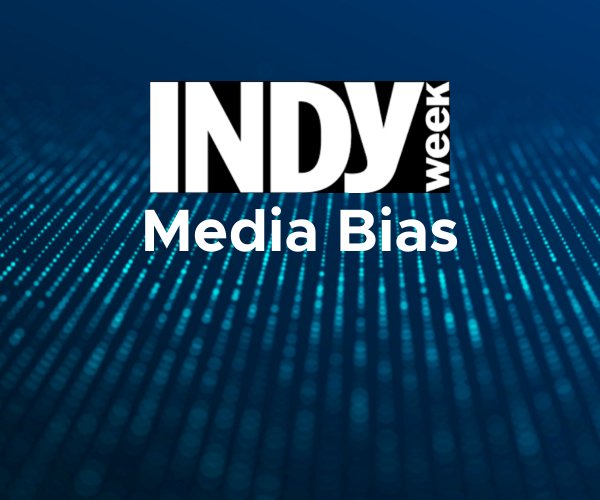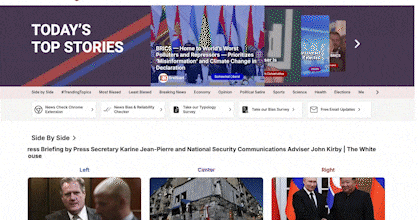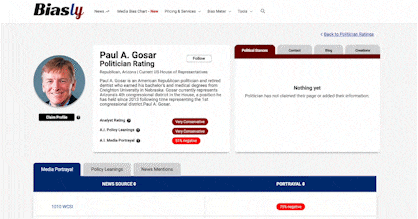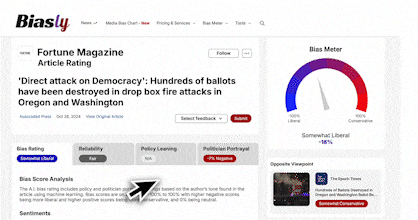
IndyWeek, established in 1983, has been a central source of news, politics, arts, and culture for the North Carolina Triangle region. Based in Durham, it has garnered a loyal readership that appreciates its investigative journalism and in-depth reporting. But is IndyWeek biased? Given its readership and the nature of its content, this question deserves a thorough analysis.
According to our understanding, the readership of IndyWeek tends to lean towards progressive viewpoints, which is reflected in the topics it often covers and the tone of its articles. In this article, we will delve into the publication’s coverage and editorial decisions to ascertain if there is a detectable political bias in their reporting. Through our analysis, we aim to shed light on whether IndyWeek is biased and highlight the factors that contribute to media bias in general.
How Does Biasly Rate News Sources?
Biasly’s algorithms produce bias ratings to help provide multiple perspectives on given articles. Biasly has analyzed 200,000+ news articles from more than 3,200 news sources through our A.I. technology and team of political analysts to find the most factual, unbiased news stories.
Biasly determines the degree of political bias in news sources by using Biasly’s Bias Meter Rating. Our team analyzes media sources’ reliability and bias and produces three scores: a Reliability Score that measures the accuracy of media sources, an A.I. Bias Score, evaluated by A.I., and an Analyst Bias Score evaluated by political analysts. These scores are rated based on seven rating metrics including Tone, Tendency, Diction, Author Check, Selection/Omission, Expediency Bias, and Accuracy. These metrics help our analysts to determine the political attitude of the article.
Our A.I. machine-learning system employs natural language processing and entity-specific sentiment analysis to examine individual articles and determine their bias levels. By analyzing the key terms in an article such as policies, bias phrases, political terminologies, politicians, and their nicknames, the algorithms can rate the attitude of the text. Bias scores range from -100% and 100%, with higher negative scores being more liberal and higher positive scores being more conservative, and 0% being neutral.
Is IndyWeek Politically Biased?
IndyWeek has, over the years, established a reputation for being somewhat liberal-leaning in its coverage. This perceived bias has led to criticisms from conservative readers who often feel that their viewpoints are not adequately represented in IndyWeek’s coverage.
Biasly’s A.I. Bias Score for IndyWeek currently sits at “Medium Liberal,” and it gave a Policy Leaning score of “Medium Liberal,” which means IndyWeek provides most political coverage from an American liberal political perspective. This rating is derived from an analysis of IndyWeek’s coverage, which often showcases liberal politicians and policies in a favorable light and criticizes conservative policies and politicians.
Our analysis of IndyWeek’s content shows a clear tendency towards progressive viewpoints and liberal causes. However, it’s important to note that bias varies by article, and IndyWeek does not exclusively publish liberal-leaning pieces and sometimes posts centrist or conservative content.
Before we begin, we need to discuss bias. Bias is a natural function of humans, and we can express it both consciously and unconsciously. Bias is one of the most fundamental forms of pattern recognition in humans. This isn’t to lower the bar and say that “all things are biased,” but to explain the process in which we may come to trust certain news organizations that display patterns of coverage.
On the media’s part, there is an incentive to retain audiences, encourage them to purchase subscriptions, and rate products positively. Bias is a two-way street, people want to see news stories about things they care about, and the media needs viewers to continue their operations. This creates a positive feedback loop that influences what stories are covered and from what perspective. This also explains the actions of more liberal news organizations.
Analysis of Bias in IndyWeek Online Articles
Indications of bias in IndyWeek’s online articles often arise from the network’s tone, tendency, author, diction, and expediency biases as outlined below.
| Type of Bias | Definition | Example in Indyweek’s Reporting |
| Tone Bias | Tone towards a particular perspective, expressing bias against specific ideas or values. | Presenting stories from a progressive point of view, favoring evidence that confirms progressive beliefs. |
| Tendency Bias | Consistency of tone and perspective across multiple articles or within a news outlet. | Consistently maintaining a liberal tone in articles, potentially leading to a left-leaning representation of the news. |
| Author Bias | Bias in the way commentators and authors interpret and analyze political events. | Praising progressive politicians and policies while criticizing conservative politicians and policies within specific articles |
| Diction Bias | Emotive words and emotionally charged language used to support or criticize certain values and policies. | In their articles, using positive language toward progressive policies. |
| Expediency Bias | Focus on first impressions, headlines, images, and clickbait to quickly capture the audience’s attention. | Crafting emotive-driven headlines or using images that appeal to a liberal audience. |
IndyWeek’s choice of topics and framing of issues further contribute to the perception of bias. The publication often covers progressive political movements, while giving less prominence to conservative perspectives on specific issues. This selective coverage can reinforce the perception of bias among readers with different ideological leanings.
It’s important to note that bias in media is not inherently negative or unethical. Bias is often a reflection of the publication’s target audience and editorial stance. IndyWeek has carved out a niche as a moderately progressive news outlet catering to readers who align with their values and interests. However, it is essential for readers to be aware of this bias and seek out diverse sources of information to gain a more comprehensive understanding of the issues.
Now, let’s look at some examples within Indyweek’s online articles.
First, we will look at the article “UNC Program seeks to Boost the Number of Black Doulas practicing in N.C.”
On IndyWeek’s website, an article by Hannah Critchfield discusses the UNC program aiming to increase the number of Black doulas practicing in North Carolina. Though informative, there are elements of bias that may influence readers’ interpretations of the topic. Below are some of the biases present in the article:
The tone of the article is mildly positive, leaning towards the promotion of diversity in the field of healthcare, particularly within the doula profession. Using phrases like “Doulas may help alleviate some of that risk,” the author frames the initiative in a supportive light. This could influence the reader’s view, encouraging a perception that more racial diversity in the profession is inherently beneficial.
Critchfield appears to have a slight liberal bias, as evidenced by the choice of language and topic. This bias could have guided her selection and portrayal of the information presented in the article. For instance, the author has a history of publishing pro-choice articles on abortion and HIV testing, revealing a liberal lean in her writings. For example, looking at the title of an article from the author, the title “Sweeping Legislation Aims to Combat Black Maternal Mortality” may be perceived as having a liberal bias as it highlights a legislative effort to address racial disparities in healthcare, an issue often prioritized by liberal platforms that focus on systemic inequities and social justice.
Furthermore, Critchfield’s consistent use of slightly positive language, such as referring to the trainers involved in the initiative as the “dream team”, reflects a tendency for an affirmative tone. This, coupled with the lack of any contrasting views or critical analysis, may denote a bias in the article. Such a presentation suggests an implicit endorsement of the UNC program’s efforts to diversify the profession, painting it in a solely positive light without examining any potential limitations or challenges. In journalism, it is essential to present a balanced view to maintain objectivity; however, in this case, the absence of counter perspectives and the subtly positive language indicates a tilt in favor of the program.
In summary, while the article provides valuable information about an initiative to increase diversity in the doula profession, it also exhibits a slight liberal bias, likely influencing readers’ perceptions and understanding of the topic.
Now, we can look at the article: “Thom Tillis and Other Republican Senators Try to Keep ‘The 1619 Project’ Out of Schools.”
On IndyWeek’s website, this article discusses Senator Thom Tillis and other Republican senators’ efforts to prevent ‘The 1619 Project’ from being taught in schools. While the article provides essential information about this issue, there are several instances of bias that may influence the reader’s interpretation. Here are the biases found in the article:
The tone of the article carries a clear liberal lean. This bias may manifest in the choice of words and the overall framing of the issue, influencing readers’ perception of the senators’ efforts. The diction of the article, while mostly mild, intensifies in certain places, adding emphasis on particular aspects of the issue, which could further color the readers’ understanding of the matter at hand.
In the article, the author discusses a program by the University of North Carolina that aims to increase the number of Black doulas to address the maternal mortality crisis among Black individuals. The author employs positive language to describe the program and its objectives, which hints at an endorsement of the initiative. For instance, the author refers to the founder’s approach as a way to “infiltrate the system,” and describes the trainers involved in the initiative as the “dream team.”
The use of such affirming language paints a commendable image of the program. However, the article does not provide contrasting viewpoints or any critical examination of potential drawbacks or challenges that the program might face. By focusing only on the positive aspects and not providing a balanced perspective with potential criticisms or differing opinions, the article displays a bias in favor of the program.
Including perspectives such as challenges faced in the past by similar initiatives, or views from professionals who might have concerns about the implementation, could have contributed to a more balanced reportage. The absence of these elements denotes an implicit bias towards a positive portrayal of the UNC program’s efforts to diversify the doula profession.
In conclusion, while the article offers valuable insights into the debate surrounding ‘The 1619 Project’, it is also permeated by left-leaning sentiments, which may influence readers’ perception and understanding of the situation.
Who Owns IndyWeek?
IndyWeek, formerly known as the Independent Weekly, is owned by ZM Indy, Inc. This media company is focused on non-profit investigative journalism and is supported by various foundations, individual donors, sponsorships, and partnerships. The editor-in-chief of Indyweek, Jane Porter, does not seem to have any specific biases. However, donors to the organization may have political biases that could impact the way the organization frames specific issues.
Understanding Political Leanings in IndyWeek
IndyWeek does have a political bias that leans towards progressive viewpoints. Its coverage, tone, and choice of topics reflect this bias. However, it’s crucial for readers to approach any news source critically and seek multiple perspectives to form a well-rounded understanding of the issues at hand. By being aware of bias and engaging with a diverse range of sources, readers can make more informed decisions and contribute to a more nuanced media landscape.

























